Logic Pro X and Ableton Live have been staples in the music production industry for years.
Both of these Digital Audio Workstations (DAWs) bring a unique blend of features, capabilities, and workflows to the table.
This makes the choice between them often a challenging one.
However, to truly pick which DAW is right for you, it’s essential to dive deep into the intricacies and nuances of each platform.
Luckily, today, we’re here to guide you through everything you need to know about these two powerhouses.
In this comprehensive guide, you will discover:
- Historical background ✓
- Key features & functions of both DAWs ✓
- MIDI capabilities ✓
- Audio manipulation abilities ✓
- Integration insights ✓
- Producer’s perspectives ✓
- Advanced tips & tricks for both DAWs ✓
- Choosing which digital audio workstation is right for you ✓
By the end of this article, armed with a thorough understanding of Logic Pro vs. Ableton, you’ll be well-equipped to make an informed decision.
And be able to select the DAW that resonates with your musical aspirations and workflow preferences.
Let’s dive in…
Table of Contents
A Brief History
In the rapidly evolving world of digital music production, understanding the roots and evolution of our favorite DAWs is crucial.
Let’s start by diving into the histories of Logic Pro vs Ableton Live.
-
Logic Pro X: From Humble Beginnings to Apple’s Gem
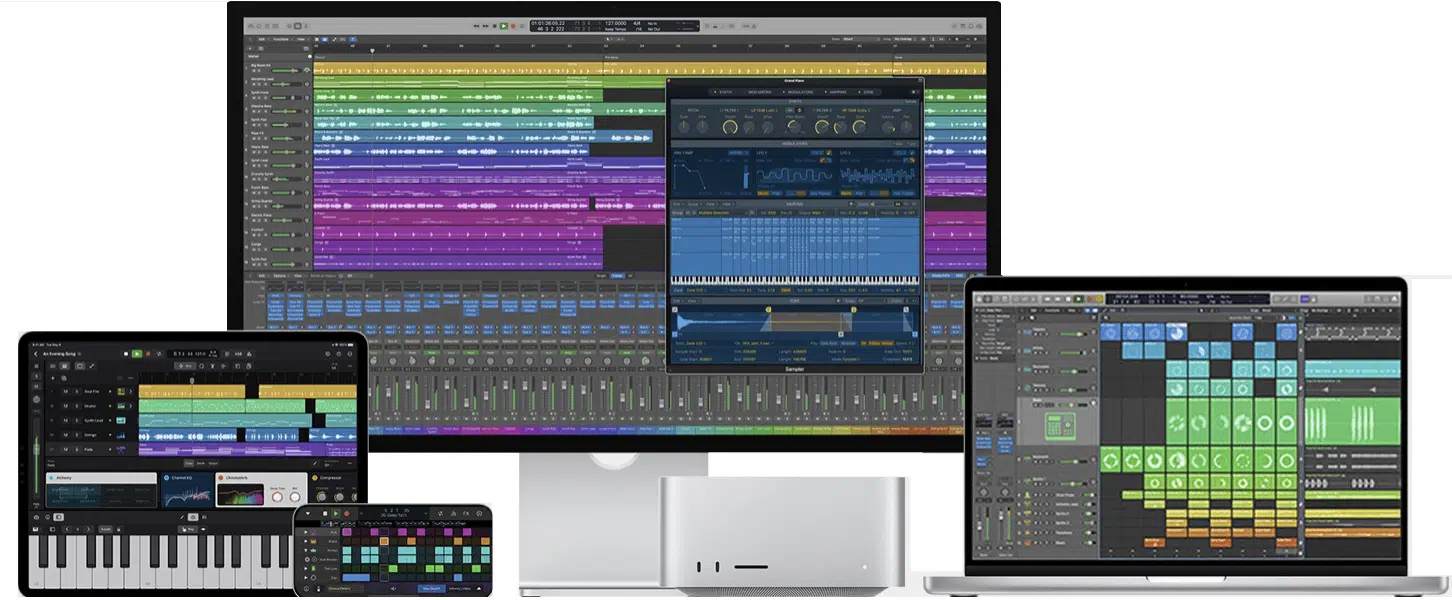
Logic Pro X, a name synonymous with professional music production today, started with relatively modest beginnings.
It’s been an incredible journey, from its initial days as Notator Logic to the powerhouse it is under Apple.
As Apple’s acquisition of Logic in 2002 took place, a series of superior advancements and precise refinements began.
Logic’s long development history is a testament to Apple’s commitment to music technology.
Over time, with features like Logic’s Alchemy and the Ultrabeat drum machine, it became the go-to DAW for many producers 一 catering to various genres.
Today, Logic Pro X is not just software…
It’s a statement, a reflection of Apple’s dedication to musicians, artists, songwriters, and producers.
-
Ableton Live: A Pioneer in Electronic Music Production
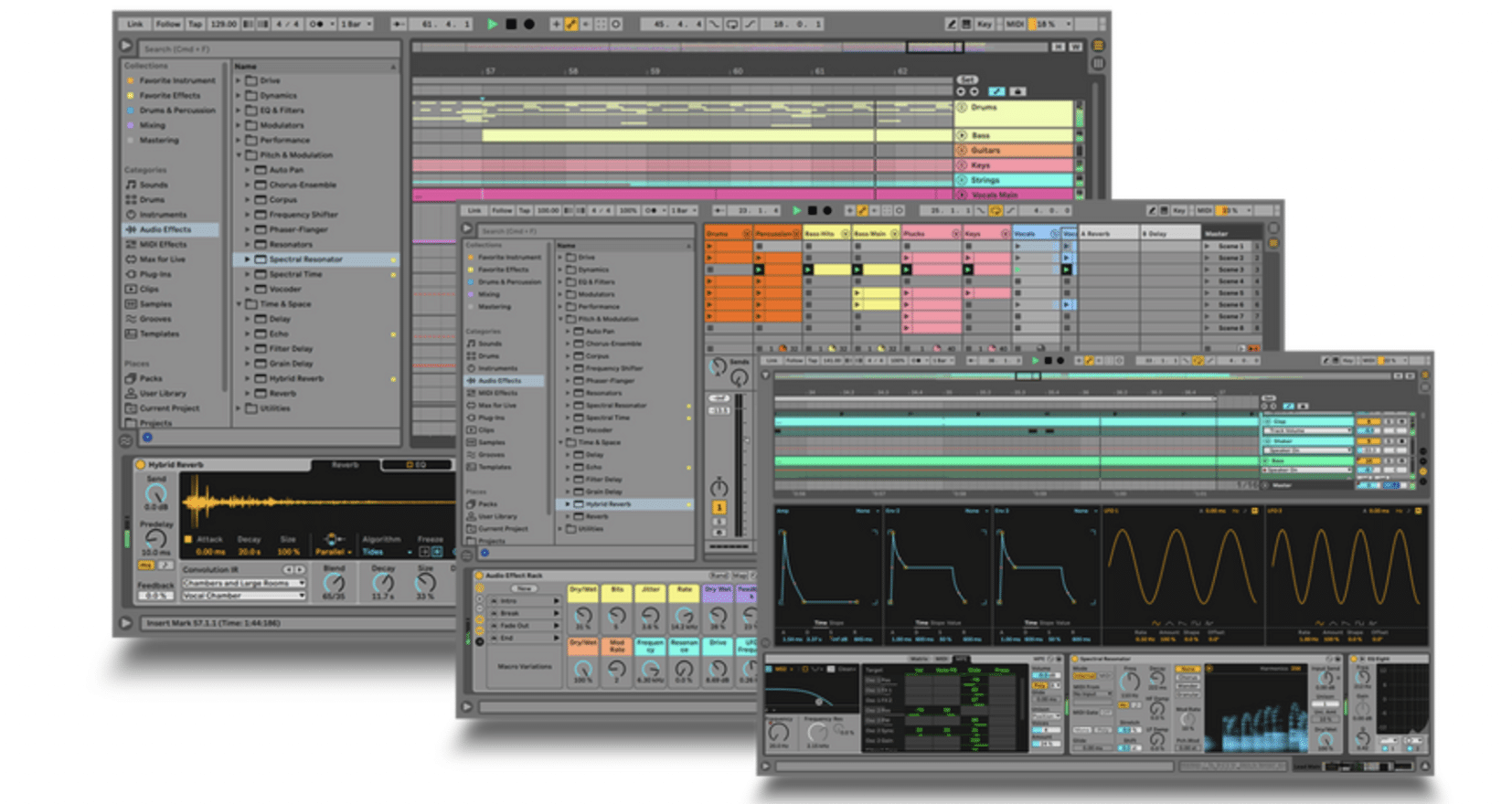
When one thinks about electronic music, Ableton Live is a name that often springs to mind.
But why has it become the emblem of electronic music production?
Launched in 2001, Ableton Live revolutionized the electronic music scene with its unique Session View 一 offering an unparalleled live performance edge.
It changed how electronic music producers approached both production and live sets.
Ableton Live wasn’t just designed as a DAW but was tailored with live electronic music producers in mind.
The fluidity it brought to MIDI programming and the flexibility of its MIDI clips set it leagues apart.
The DAW’s continuous evolution and its commitment to serving electronic music producers have made it a staple in the world of EDM, trance, house, and more.
Logic Pro X: Standout Features
With a clear understanding of Logic’s journey, let’s delve deeper into what makes it truly shine in the realm of music production.
-
Audio & MIDI Capabilities
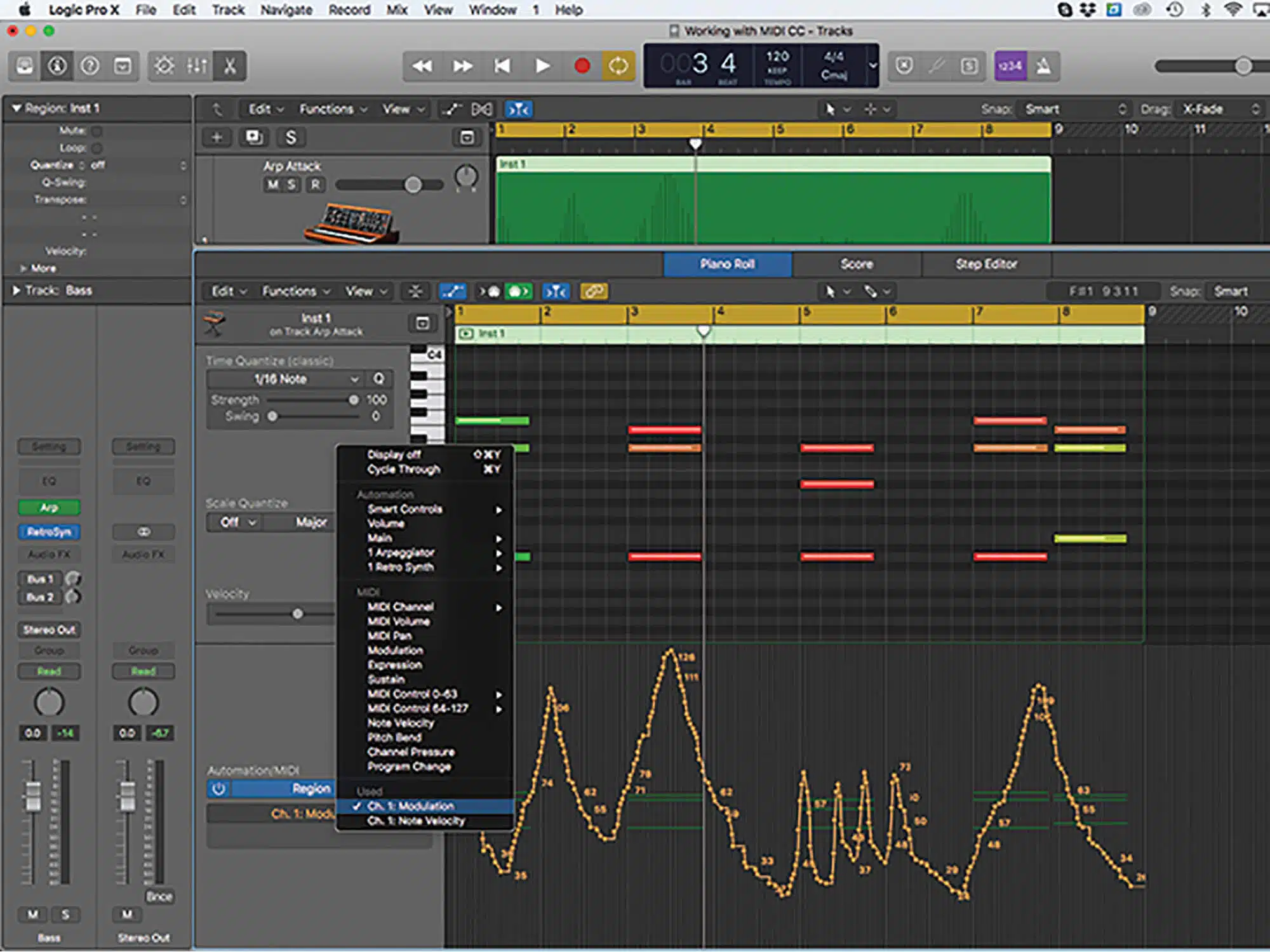
In the world of digital music, clear, crisp, and impeccable sound quality is paramount.
Logic Pro X ensures audio recording that stands out.
With a robust engine, it can handle high-resolution audio and capture the nuances of every instrument and vocal.
This, combined with its powerful audio editing tools, makes it a top choice for professional studios.
MIDI, the backbone of digital music, is something Logic Pro X has perfected over the years.
The MIDI sequencer in Logic is intuitive 一 allowing music producers to easily craft, edit, and manipulate MIDI data.
MIDI loops, effects, and instruments are seamlessly integrated, offering users a comprehensive environment.
NOTE: We’ll break down the MIDI capabilities of both DAWs later on.
Editing audio in Logic is more than just cutting and pasting.
- Flex Time 一 Allows you to manipulate the timing of your recordings without affecting the pitch.
- Flex Pitch 一 Offers natural-sounding pitch correction, making sure those vocal lines hit every note perfectly.
Logic Pro X doesn’t limit users when it comes to audio tracks or MIDI formats.
Its ability to support a myriad of audio tracks, MIDI loops, and instruments ensures that you have the flexibility you need.
Whether you’re crafting a simple track or an orchestral masterpiece.
-
User Experience and Workflow
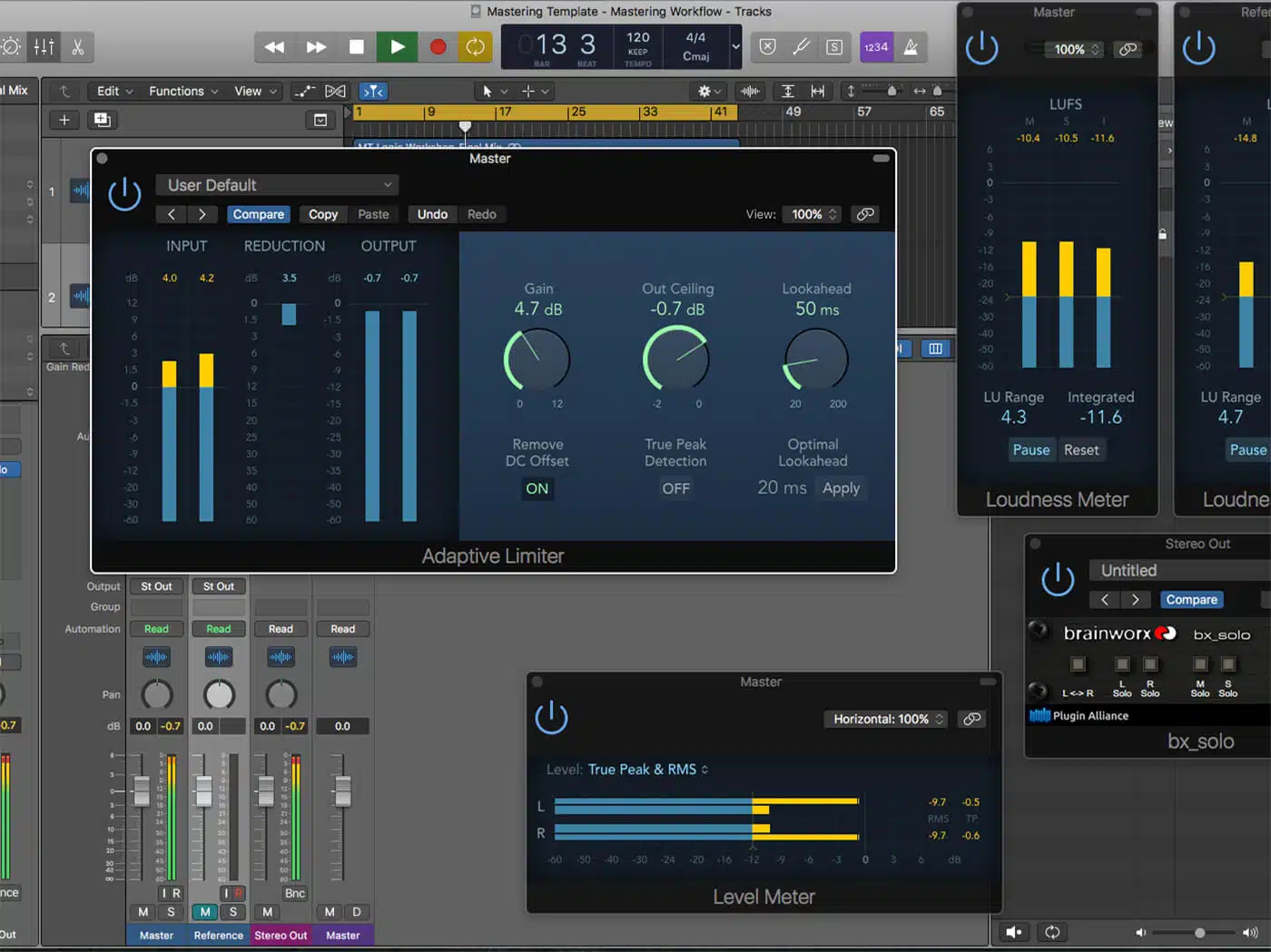
Logic Pro X has always prided itself on offering an intuitive interface.
It’s designed in a way that both beginners and seasoned professionals find easy to navigate.
Certain functions are strategically placed in order to minimize the learning curve, like:
- The main dashboard
- Arrangement view
- Various toolkits
The software promotes a fluid production process.
Features like the live loops grid enhance creativity 一 letting producers experiment with loops in real-time.
Meanwhile, the Quick Sampler allows for speedy sample manipulation, turning any sound into a playable instrument.
One size doesn’t fit all, and Logic Pro X understands that.
The DAW allows you to customize your workspace and ensures you have quick access to your most-used tools.
Additionally, with the Logic Remote app, users can even control the DAW from their iPads; offering flexibility like never before.
While Logic Pro X is user-friendly, it doesn’t compromise on offering advanced tools.
The mouse pointer editing tools, integrated channel EQ, and other advanced features ensure that professional musicians have the power they need to perfect their tracks.
-
Instrument & Effects Arsenal
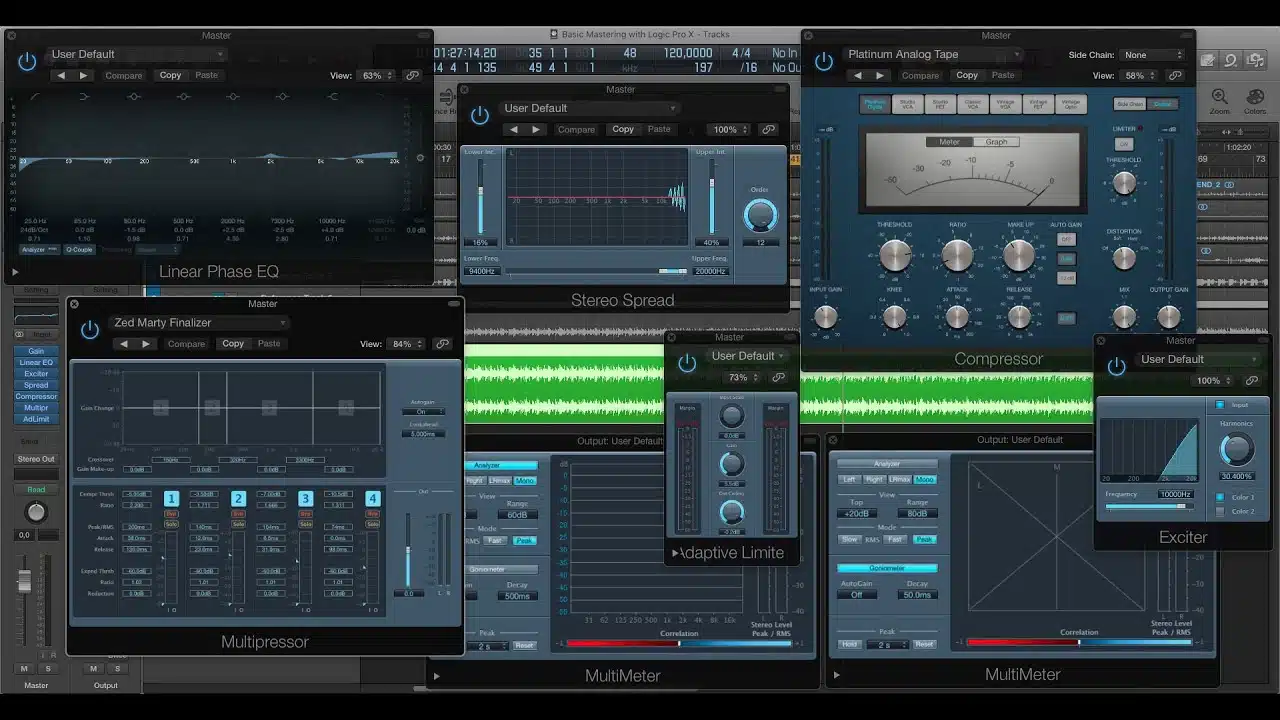
Among the many reasons music producers love Logic Pro X is its vast collection of software instruments.
From the warm tones of Logic’s retro synth to the pulsating beats of the Ultrabeat drum machine, there’s an instrument for every sound imaginable.
For electronic music aficionados, the variety it offers is unparalleled.
Logic Pro X isn’t just about instruments 一 its effects library is also a true treasure trove.
Logic’s audio effects menus are comprehensive, offering tools to shape and mold sound to perfection.
NOTE: And with support for third-party Audio Units (including the mobile AUv3 format) the possibilities are endless.
While MIDI programming paradigm in many DAWs can be standard, Logic Pro X takes it a notch higher.
With its audio units MIDI FX racks and a powerful MIDI environment, it offers unparalleled control over MIDI data.
Meaning, you can craft intricate electronic music compositions with ease.
Logic’s deeper editing tools, combined with its array of virtual instruments, offer a playground for sound designers.
Whether one’s shaping sounds using Logic’s MIDI architecture or using the CPU-saving track freezing feature, Logic ensures an organic-sounding music production every time.
-
Integration and Performance
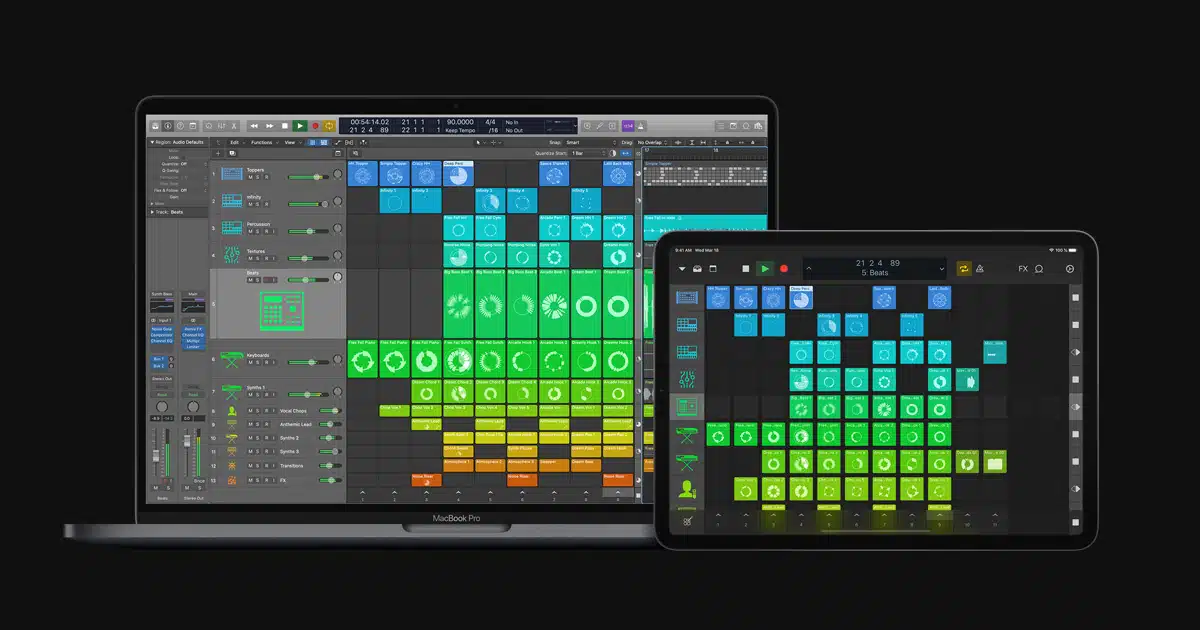
Owned by Apple, Logic Pro X benefits from tight integration with Mac hardware.
This means:
- Faster performance
- Stability
- The software will make the most of Apple’s latest tech innovations
In today’s digital world, mobility is key…
Logic’s remote app lets producers control their sessions from an iPad.
Whether adjusting levels or triggering samples, this feature exemplifies the future of music production.
With the growing trend of remote collaborations, Logic Pro X ensures producers can work together regardless of distance.
Share sessions, bounce tracks, and even collaborate in real-time (thanks to Ableton’s link technology) 一 bringing global talent to your project.
Logic Pro X is also optimized to make the most of your computer’s resources.
Whether using Logic’s long development history to ensure backward compatibility or its advanced audio manipulation tools, the software always runs smoothly.
This makes Logic Pro a favorite for professional music production studios.
Ableton Live: A Deep Dive
Having explored the intricacies of Logic Pro X, it’s now time to shift our focus to the other titan in this comparison: Ableton Live.
As we dive into the depths of Ableton’s rich features and unique capabilities, one of the first aspects we’ll uncover is the software’s revolutionary ‘Rack’ system.
-
The Benefits of Ableton’s Exclusive ‘Rack’

Ableton Live introduced the concept of ‘Racks,’ which changed the electronic music production game forever.
Racks allow multiple devices (within Ableton Live and 3rd party plugins alike) to be grouped together.
This enhanced workflow tenfold and allowed for super unique sound design possibilities.
Ableton’s take on MIDI effects is also ingenious.
MIDI FX racks in Live let you:
- Chain multiple MIDI effects.
- Create intricate patterns and sequences.
For producers keen on complex MIDI programming, this is a game-changer.
Beyond MIDI, Ableton’s audio effect racks offer a playground for sound designers and sound design enthusiasts.
Chain effects, create parallel processing chains, or craft a unique signal flow 一 the flexibility is unmatched.
Yes, especially for electronic music producers.
Crafting layered sounds or complex instrument setups? Ableton’s Instrument Racks make it a breeze.
You can layer and play multiple instruments, map controls to macros, and create evolving soundscapes effortlessly.
-
Interface and Usability
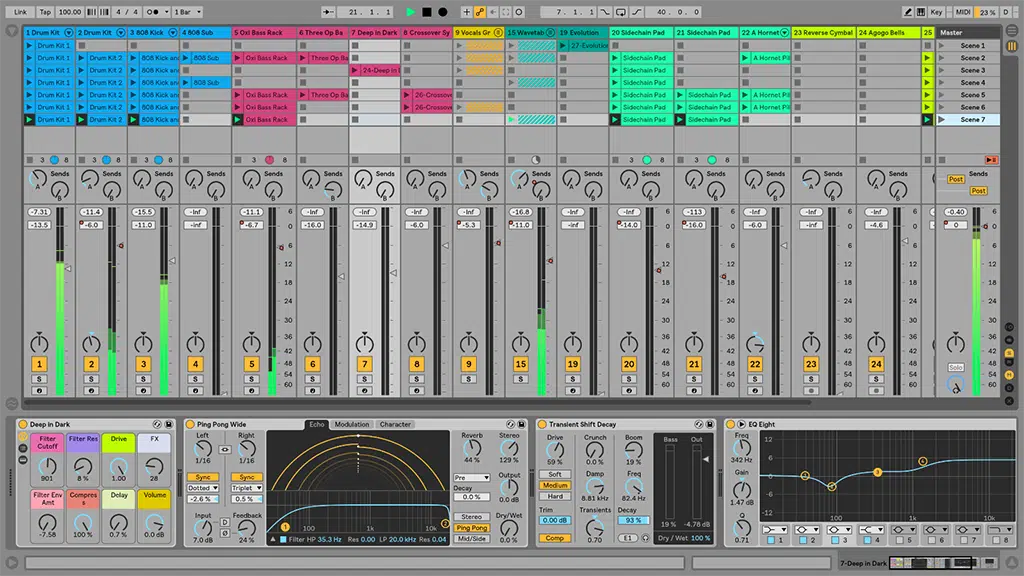
One of the hallmarks of Ableton Live is its intuitive interface, yet behind its apparent simplicity lies deep functionality.
Its dual-view system (the Arrangement View & Session View) allows producers to swiftly switch between:
- A traditional ‘linear’ digital audio workstation layout.
- A more experimental, clip-based interface.
Ableton’s famous browser panel is also a masterclass in design.
Whether searching for MIDI clips, audio tracks, or third-party plugins, everything is a simple drag-and-drop process.
Plus, the inclusion of a search function ensures that no tool or sound is ever more than a few clicks away.
The real power users of Ableton Live often rely on its customizable keyboard shortcuts.
Whether you’re triggering a MIDI clip, adjusting the piano roll, or slicing audio clips, custom shortcuts can speed up the process and enhance workflow.
-
Sound Tools and Add-ons
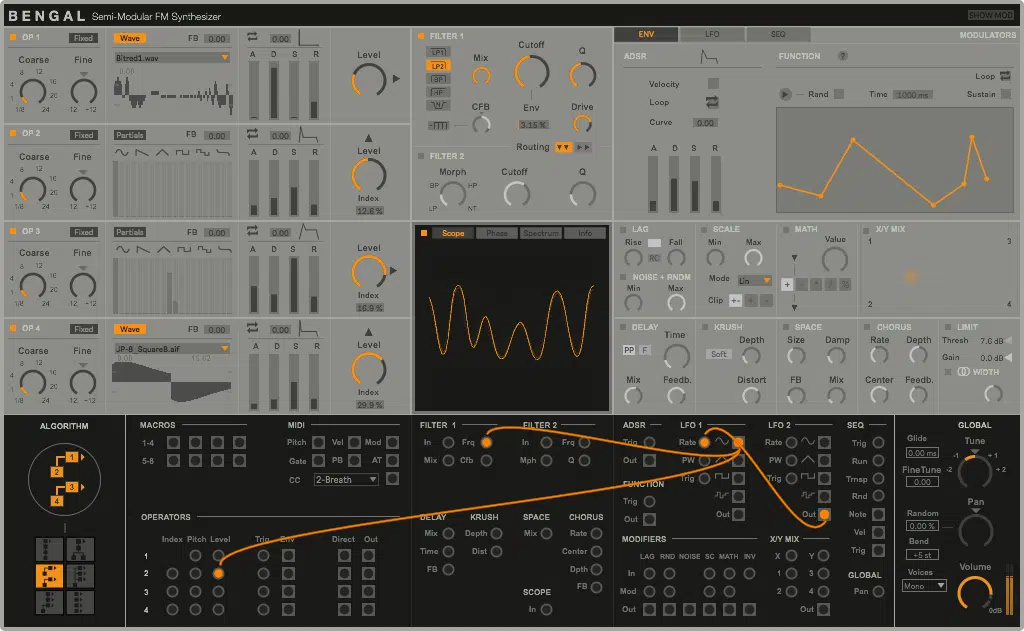
Ableton Live boasts a rich array of virtual instruments tailored for electronic music.
Whether diving into the resonant world of its analog synth or crafting beats with the dedicated drum machine, producers have a plethora of choices at their fingertips.
Ableton Live isn’t just about instruments.
Its suite of audio effects ensures your tracks sound pristine, from warm analog emulations to cutting-edge modulation effects.
MIDI FX, too, allows for intricate sequencing and pattern generation… talk about pushing boundaries!
Also, Max for Live integrates the Max/MSP environment into Ableton Live.
This means you can successfully build your very own:
- Instruments
- Effects
- Music production tools
It’s not just music production 一 it’s audio innovation.
Ableton Live excels in sample management; its browser allows easy access, but it’s the warp modes that stand out.
They let producers time-stretch and pitch-shift samples in real-time, an invaluable feature for electronic music producers.
-
Live Performance Mastery
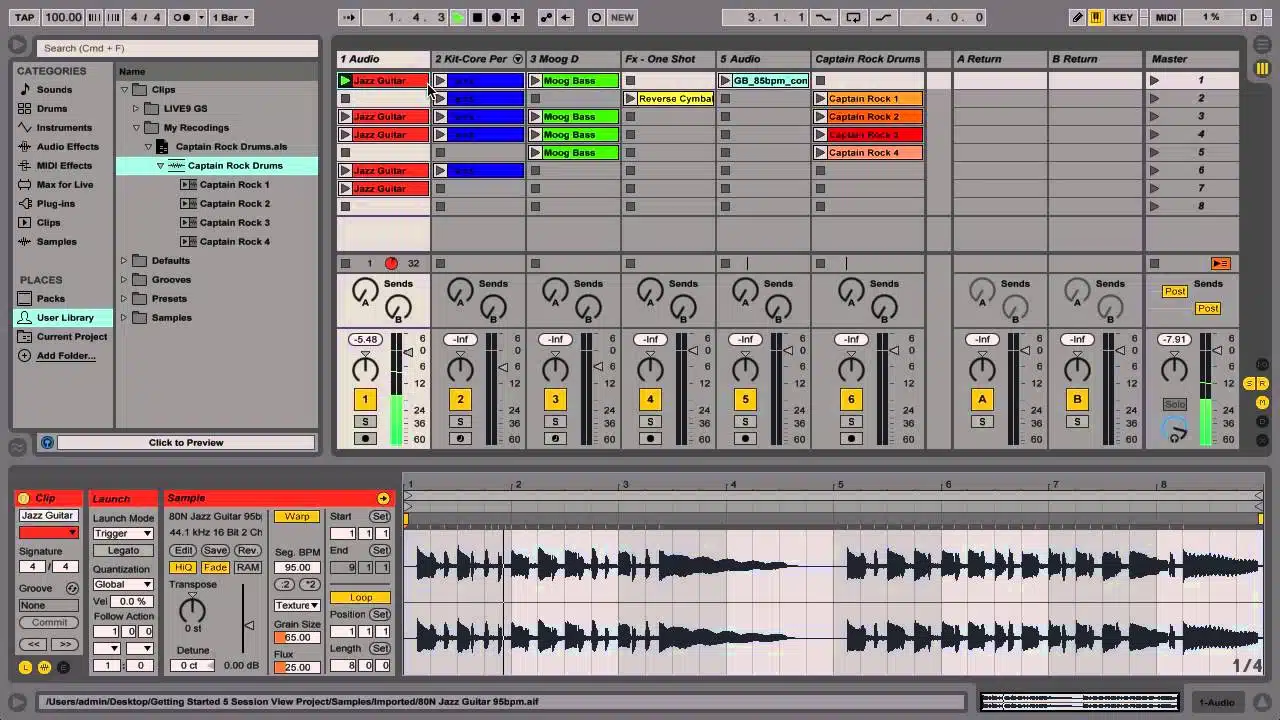
Ableton’s Session View isn’t just an alternate layout, it’s the epicenter of Ableton’s live performance capabilities.
Meaning, you can successfully:
- Launch clips
- Tweak parameters
- Basically DJ their own produced tracks with ease
Ableton Live doesn’t just cater to the digital realm… integrating own live instruments into a set is seamless.
It allows for a blend of organic and synthesized sounds during live performance.
NOTE: For those using controllers during a live set, Ableton’s MIDI mapping is intuitive and flexible.
From launching clips to adjusting EQ on-the-fly, every function can be assigned to a MIDI control.
In a live scenario, latency can be a showstopper.
Thankfully, Ableton’s robust latency management ensures that everything stays in sync, whether you’re triggering MIDI loops or processing live vocals with effects.
Deciphering MIDI Capabilities: Logic Pro vs Ableton Live
As a modern-day digital music producer, you’ll find the need to intertwine software instruments and external gear.
Let’s explore how these two powerhouses deal with MIDI.
-
Logic’s MIDI Environment
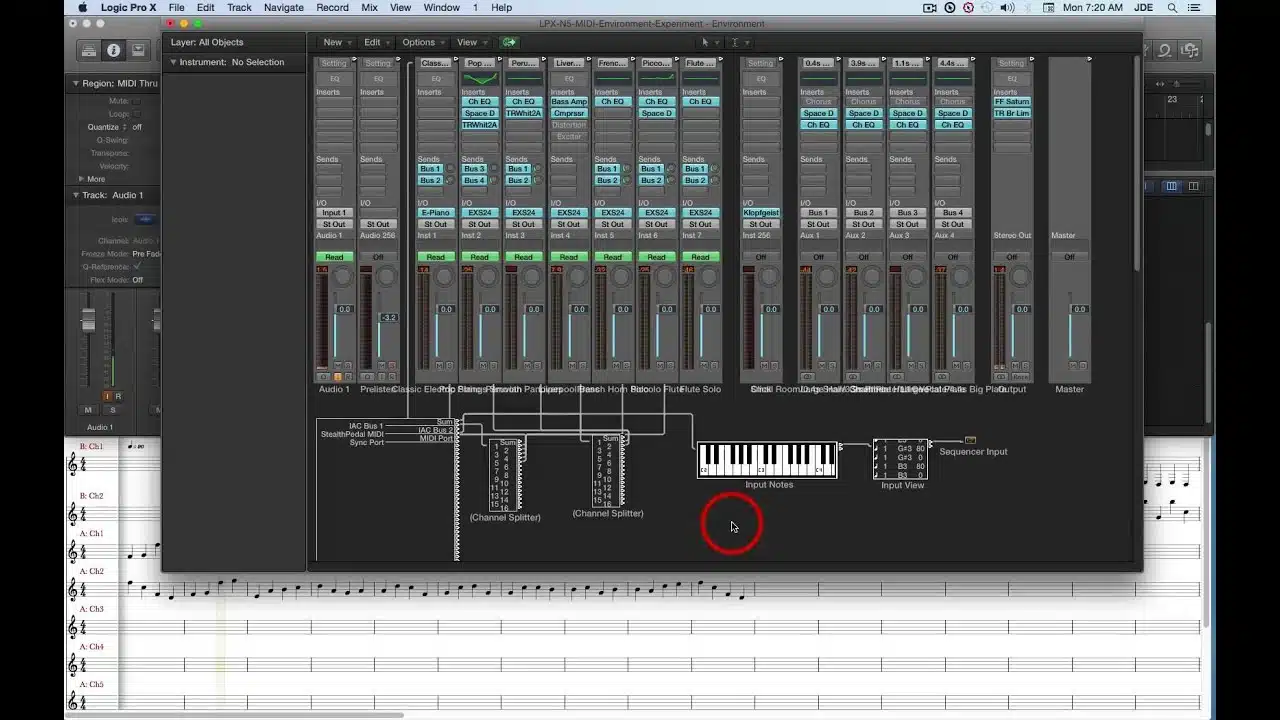
Logic Pro X’s deeper MIDI editing capabilities are a result of Logic’s long development history.
From its MIDI programming paradigm to its handy inspector-based MIDI tools, this DAW ensures a smooth experience.
Logic’s MIDI architecture, apart from its traditional MIDI sequencer, offers the powerful Environment window.
Here, MIDI signals can be:
- Rerouted
- Transformed
- Processed in real-time
This provides an expansive playground for advanced MIDI manipulations.
The integration of Logic’s track stacks with MIDI instruments provides a method to combine multiple instruments under one umbrella track.
Which is super beneficial for complex layering.
The Step Editor in Logic Pro X facilitates precise percussive note input 一 transforming the MIDI voice into a rhythmic powerhouse.
Logic’s MIDI effects (especially the Chord Trigger and Arpeggiator) elevate the game by offering real-time chord expansions and diverse rhythmic patterns, respectively.
-
Ableton’s MIDI Abilities
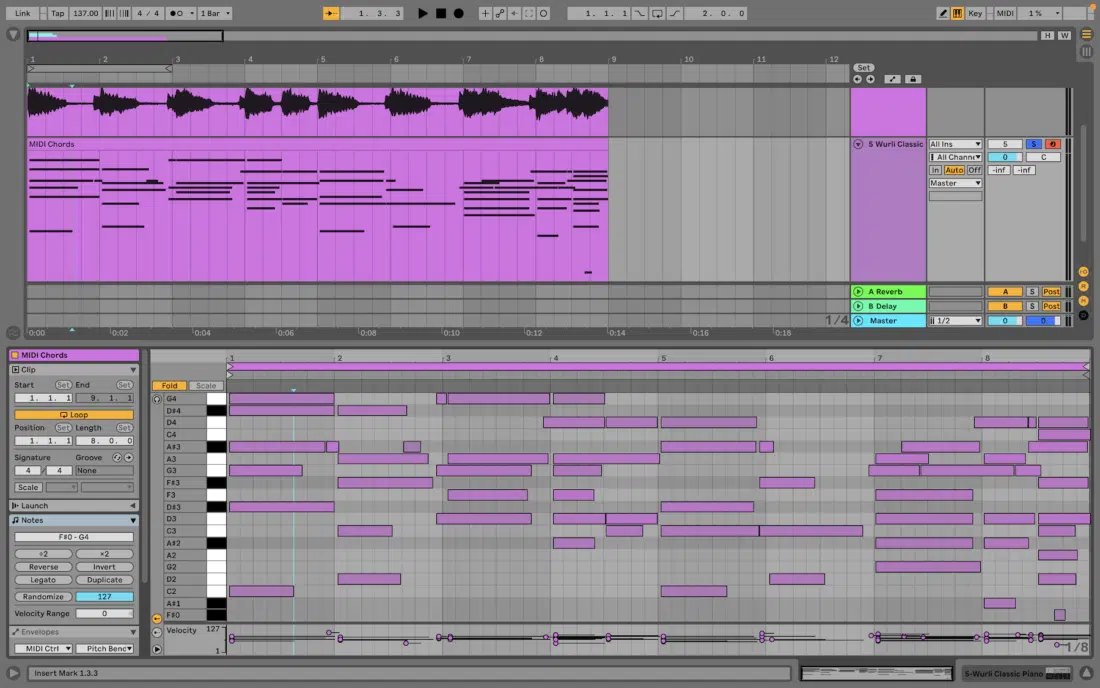
Ableton Live handles MIDI clips in a revolutionary way.
With the Session View in Ableton Live, you can launch, loop, and experiment with MIDI clips 一 offering an intuitive interface that caters to everyone.
Aside from its intuitive interface, Ableton’s Rack system is another wonder.
By encapsulating MIDI effects, instruments, and audio effects into one Rack, you have the power to:
- Craft custom instruments
- Layer sounds
- Even split keyboards
Where Ableton Live shines is its Max for Live integration.
With Max, custom MIDI effects, instruments, and audio processors can be created, leading to unparalleled customization.
The MIDI Capture function in Ableton Live is a game-changer.
Ever played something you wish you’d recorded?… Simply hit the Capture button, and Ableton Live retrieves your recent performance (epic, right?).
Ableton’s integration with dedicated controllers ensures that MIDI mappings are seamless.
Ultimately, enhancing llive performances and making MIDI manipulations fluid.
The Art of Audio Manipulation
Beyond MIDI, manipulating audio directly is an art.
How do Logic Pro vs Ableton Live enable the digital artisan in you?
Let’s find out…
-
Logic’s Flex-ibility
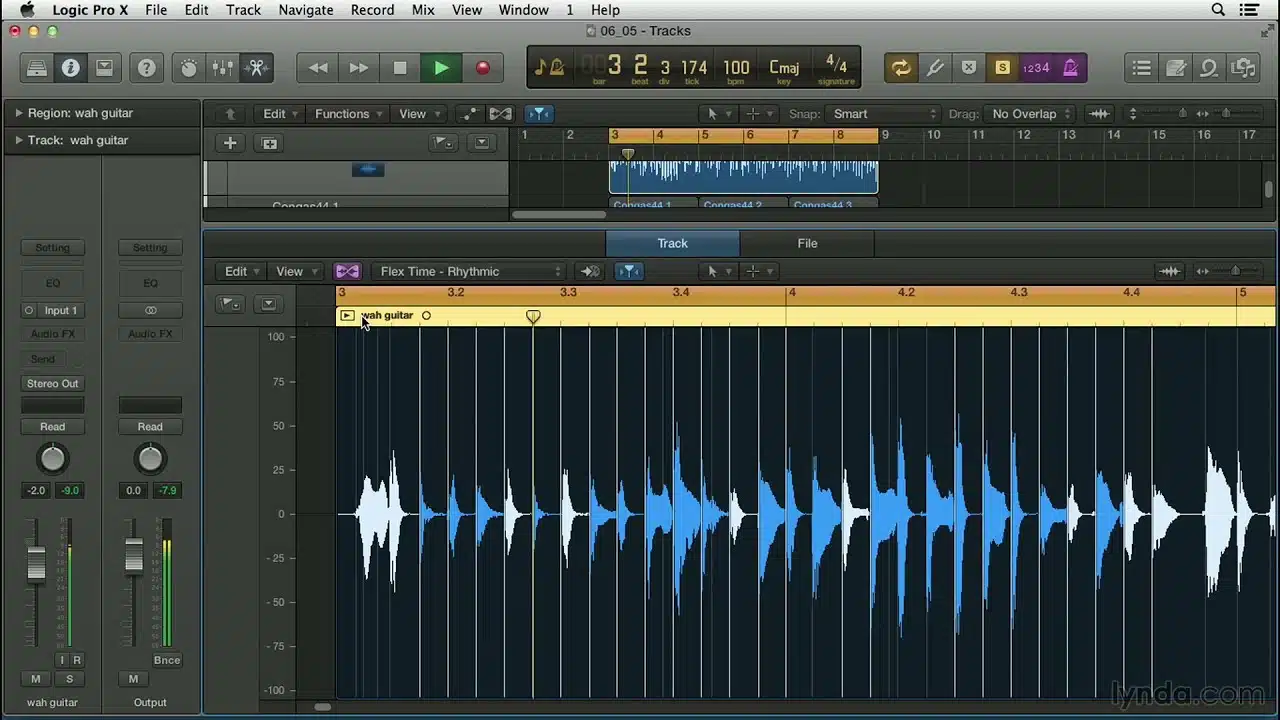
As we touched upon earlier, Logic Pro X introduced Flex Time and Flex Pitch.
These parameters provided natural-sounding pitch correction and allowed for intuitive time manipulation without sacrificing audio file quality.
Logic’s audio effects menus is another big selling point.
From the Space Designer reverb to its Vintage EQ collection, the tools at your disposal make editing audio a creative endeavor.
With its CPU-saving track freezing feature, Logic ensures that audio manipulation remains smooth.
Yes, even when your producing music and projects that get super dense.
Logic’s track stacks offer a quick and efficient way to group audio tracks 一 facilitating a more organized workflow when dealing with multiple audio clips.
The Quick Sampler, which is a new addition separate from Logic’s classic ESX24 redesign (now ‘Sampler’) allows you to quickly turn any piece of audio into a playable instrument.
Whether it’s a groovy drum loop or a vocal phrase, you can morph anything imaginable.
-
Ableton’s Audio Magic
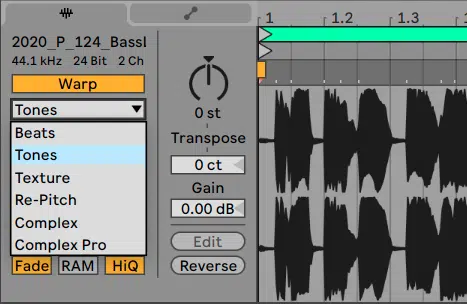
Ableton’s Warping feature is a dream come true for electronic music producers.
It allows audio clips, without any hit to their inherent character, to be:
- Time-stretched
- Pitched
- Reversed
Audio to MIDI is another remarkable feature in Ableton Live.
By converting audio drum patterns, melodies, or harmonies into MIDI data, it provides a fresh approach to both sample-based and original music production.
NOTE: You can even just hum a melody and it can pick that up.
The Grain Delay and Erosion effects within Ableton Live open up a realm of sonic possibilities as well.
They transform ordinary audio clips into textured, evolving soundscapes.
Ableton’s Simpler and Sampler instruments offer intuitive and deep audio manipulation tools.
From granular synthesis to multisampling techniques, they provide immense sound-shaping capabilities.
In the realm of audio loops, Ableton’s Session View presents a different approach.
It facilitates real-time triggering and manipulation of loops 一 which is pivotal for electronic music performances.
Logic Pro vs Ableton: Breaking It Down Further
Now that we’ve delved into the individual strengths and features of both Logic Pro X and Ableton Live, it’s essential to compare them side-by-side.
This way we can dissect the key differences and similarities.
A crucial component to kickstart this comparison is examining how each DAW approaches plugins and third-party integrations.
-
Plugins & Third-party Integrations: Logic Pro vs Ableton
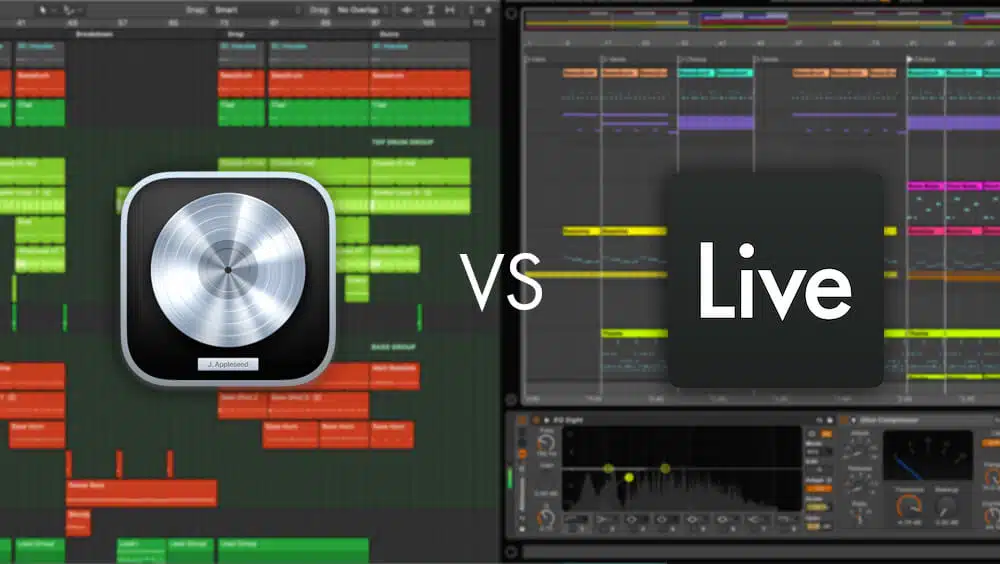
To start off this head-to-head battle, let’s talk about plugins and third-party integrations, which we all know is super important.
#1. VST vs Audio Units
Logic Pro X primarily uses Audio Units (AU) format for plugins, ensuring tight integration with macOS.
Ableton supports VST and AU, offering a bit more flexibility.
Especially for those who’ve amassed a large collection of VST plugins, like myself.
#2. Native Instruments & Effects
Both DAWs come packed with a range of native instruments and effects.
- Logic’s track stacks and MIDI architecture might appeal to those who enjoy layered sounds.
- Ableton’s rack system provides an innovative approach to sound design.
#3. Max for Live vs Logic’s Scripter
While Max for Live offers Ableton users a world of custom instruments and effects, Logic’s Scripter allows for MIDI manipulation using JavaScript.
Essentially you can script your own version of a MIDI FX plugin from the ground up.
Two different approaches, both offering deep customization.
-
Integration with Hardware: Logic Pro vs Ableton
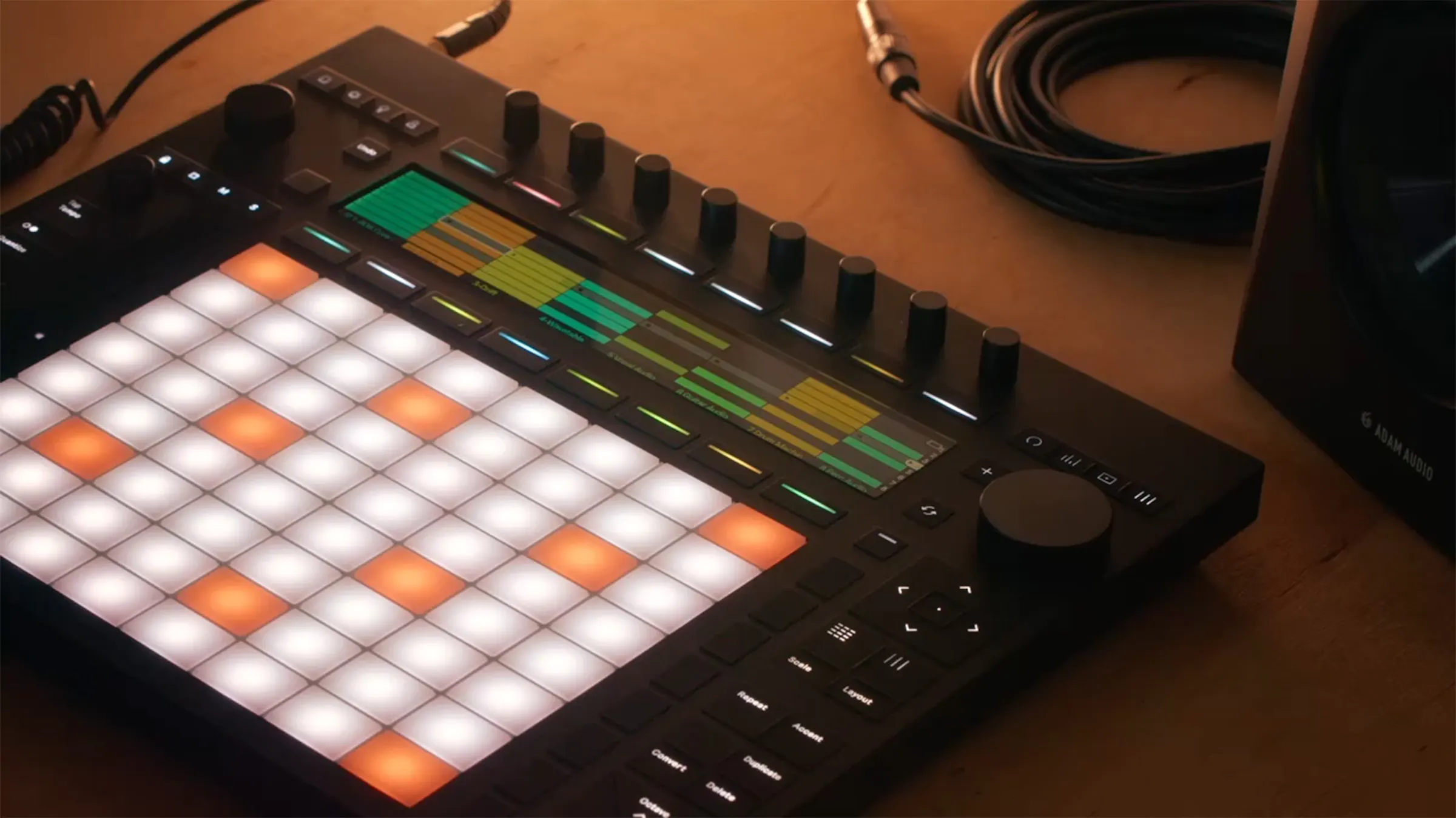
Now let’s breakdown both unique DAWs integration with hardware.
#1. Ableton’s Push vs Logic’s Control Surfaces
While Ableton has the Push, a dedicated controller built specifically for it, Logic Pro X Remote boasts deep integration with your IOS device.
Both provide tactile control over their respective software.
#2. Recording External Instruments
When it comes to audio recording from external sources, Logic Pro X offers a slightly more refined experience.
It includes features tailored to recording multiple takes and comping them together.
#3. Latency Management
Logic tends to have an edge here, especially when used with Mac hardware.
Ableton is no slouch, but Logic’s deep macOS integration can lead to slightly better latency figures in some setups.
-
Versatility & Scalability: Logic Pro vs Ableton
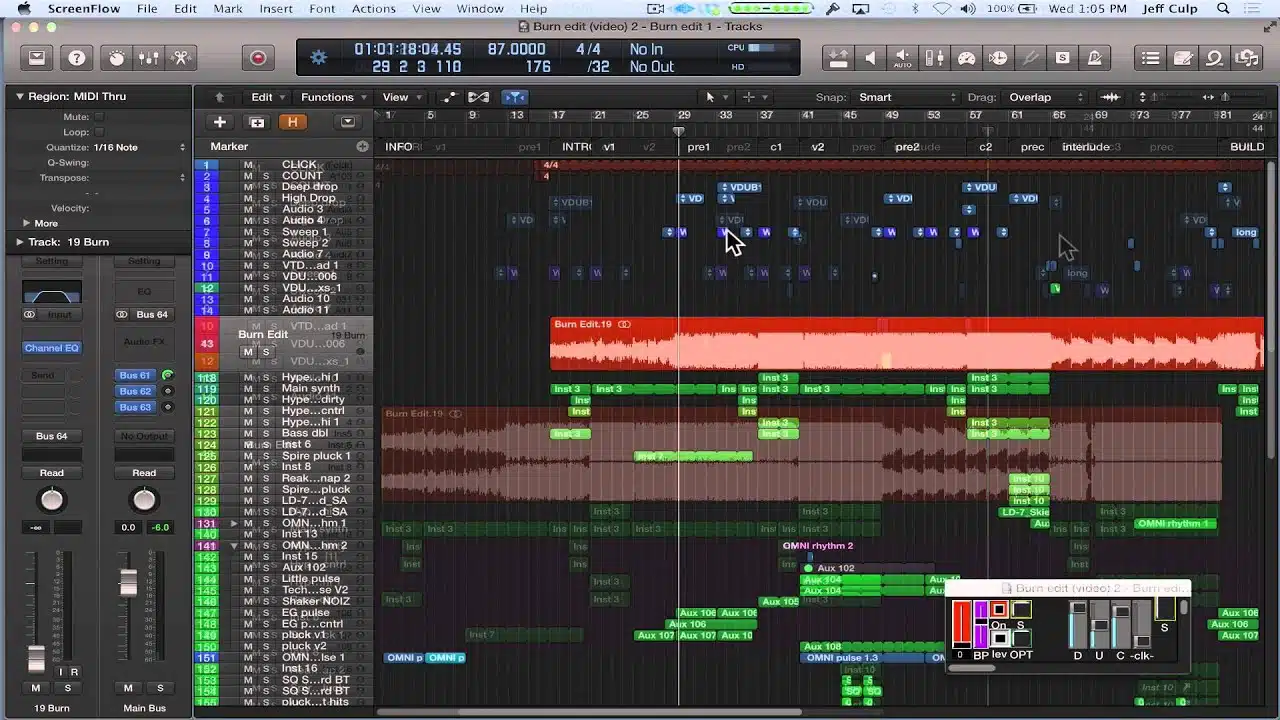
For this last head-to-head section, we’re going to be discussing the flexibility and scalability of both premium DAWs.
#1. Adaptable Interface
Both DAWs come with highly adaptable interfaces.
Ableton is known for its Session and Arrangement Views that cater both to live performers and traditional producers.
Logic Pro X, with its customizable environment and windows, ensures each user can create a workspace tailored to their workflow.
#2. Scalability with Track Counts
Logic Pro X is renowned for its scalability, handling hundreds of tracks seamlessly.
This makes it a favorite among orchestral composers and producers working with large projects.
Ableton, while efficient, is often perceived as better for projects that don’t stretch into the high track counts.
#3. Session Handling and Cloud Services
Logic’s integration with iCloud allows for easy sharing and backups, a feature cherished by many Apple users.
Ableton lacks a built-in cloud service but makes up for it with easy project consolidation features.
#4. Advanced MIDI Capabilities
Both DAWs provide advanced MIDI editing features, but their approaches differ.
Logic’s MIDI transform window offers an array of tools for complex manipulations, while Ableton’s MIDI effects can achieve intricate sequencing patterns and transformations.
Producer Tips & Tricks
Beyond the fundamental features and specifications, mastering any DAW requires delving into its unique quirks, shortcuts, and hidden gems.
As we venture into this section, we’ll begin with ways to significantly enhance your workflow in Logic Pro X.
This will make sure you harness the full potential of this music production powerhouse.
-
Enhancing Workflow in Logic Pro X
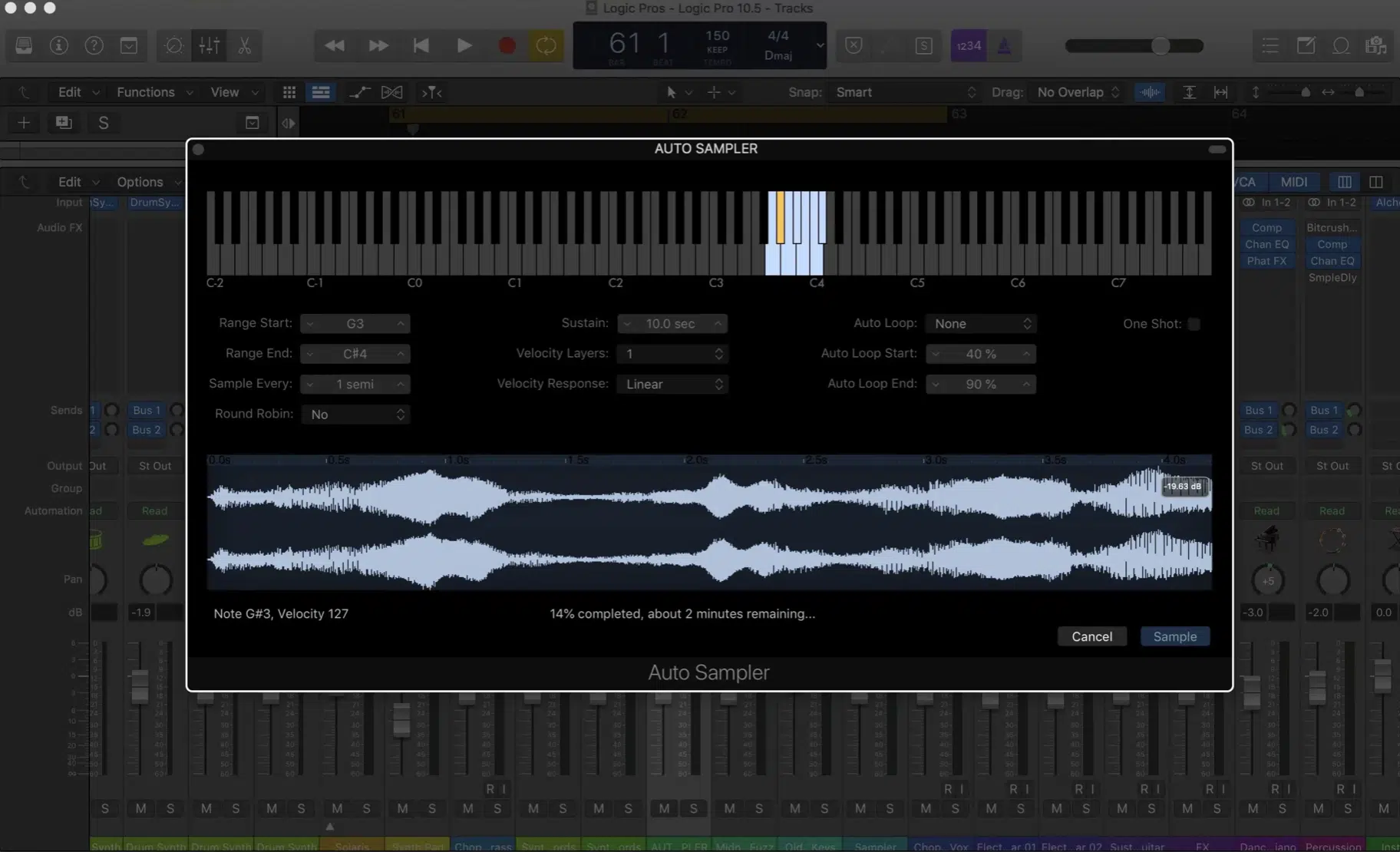
Logic’s Smart Controls allow for the manipulation of multiple plugin parameters simultaneously.
Mapping these controls to a MIDI controller can supercharge your workflow.
For those dealing with dense arrangements, Logic’s Track Stacks consolidate multiple tracks into one collapsible folder, providing:
- A cleaner workspace
- Grouped mixing
The power of Logic’s Quick Sampler for speedy sound design.
Its Auto Sampler can convert any preset, plugin, or hardware synth sound into a fully playable digital instrument.
Logic’s Marquee Tool isn’t just for selection…
Dive into its hidden features (like quickly creating splits and applying fades) to enhance editing speed.
-
Unleashing Ableton Live’s Potential
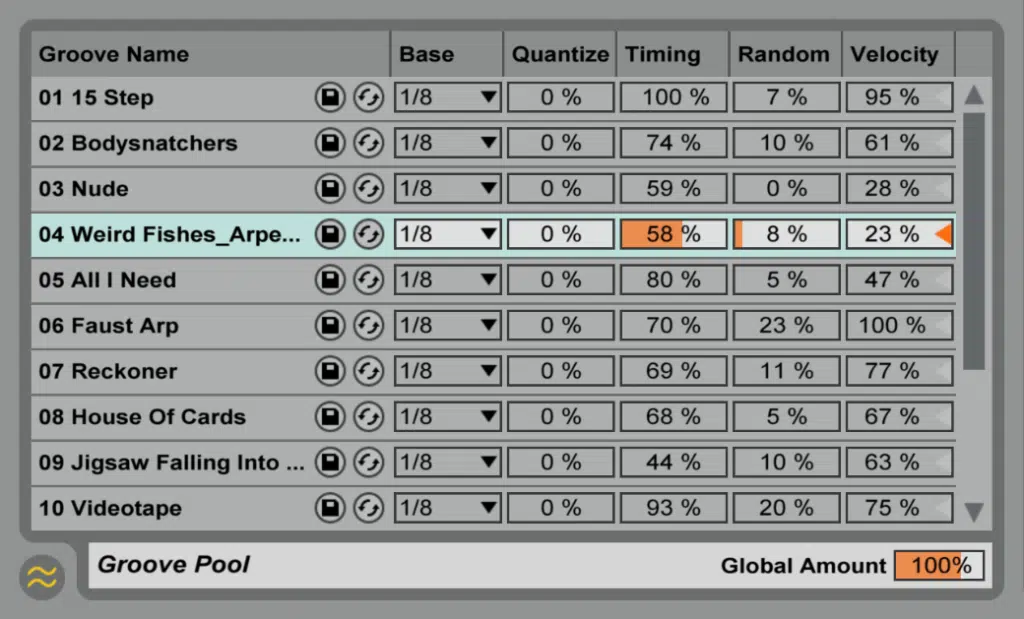
Make sure to explore the immense power of Ableton’s clip launching.
By adjusting launch quantization and follow actions, live performances can become intricate and unpredictable.
Ableton’s Groove Pool isn’t just for applying swing.
Delve into its depth to extract grooves from existing audio 一 applying them to any MIDI or audio clip.
Harness Ableton racks for parallel processing.
By splitting chains within a rack, users can apply effects to only specific frequencies or layers of a sound.
Finally, don’t lose inspiration!
Ableton’s (and Logics) MIDI capture constantly records MIDI data in the background, ensuring no inspired performance is ever lost.
Which One is For You?
The debate of Logic Pro vs Ableton isn’t just about features and capabilities; it’s also about aligning with your musical goals and aspirations.
As we transition into this section, we’ll help guide your decision by highlighting how each DAW caters to specific roles.
-
For the Live Performer

Ableton stands out for live performers due to its clip-based approach.
This allows for on-the-fly rearrangements and improvisations during any live set.
While both DAWs can integrate live instruments, Ableton’s Session View offers an edge in terms of flexibility during live performance.
Ableton’s tight integration with the Push controller makes it a favorite for those looking to manipulate sounds live.
As well as its wide support for other MIDI controllers, naturally.
Ableton’s ease of use in terms of applying real-time effects and transitions between tracks ensures that the live performance stays dynamic and engaging.
So, if you’re a live performer, Ableton might be the choice for you, as live users spend hours raving about it.
-
For the Studio Producer

Apple’s Logic Pro X’s in-depth audio and MIDI editing capabilities make it a favorite for producers who want precision and control over their tracks.
Logic’s suite of virtual instruments and effects (from Alchemy to Space Designer) ensures that producers have every tool they need within the program.
For those recording bands or vocalists, Logic’s take and comping system, combined with its pristine audio engine, make it a top choice.
Logic’s mixer, coupled with its advanced metering tools and integration with third-party plugins, offers a comprehensive environment for finalizing tracks.
So, if you’re producing in your home studio, Logic Pro X might just be the better choice.
Logic Pro vs Ableton: Final Thoughts
In the vast realm of music production, understanding the capabilities of these two music production powerhouses like Logic Pro vs Ableton is no small feat.
As we’ve journeyed through their histories, standout features, and unique strengths of Ableton vs Logic, you can see both these DAWs bring remarkable value to the table.
But, for producers keen on not just understanding, but also mastering the structure of hits in their genre, there’s an invaluable tool to consider.
Enter: the free Famous Beatmaker Template Essentials.
This collection doesn’t just serve as a learning tool; it’s an accelerator for your music production journey.
Whether you’re an Ableton enthusiast or a Logic Pro aficionado, these templates are tailored for both platforms and provide you with the exact structure of hit tracks.
The beauty lies in the flexibility they offer.
While the skeleton of a potential hit is provided, the life, the vibe, and the essence, that’s all you.
Use any sound, tweak it to your heart’s content, and make the template a reflection of your unique style.
When it comes to “Logic Pro vs Ableton,” there isn’t a definitive ‘better’ option 一 it’s all about what aligns with your goals, workflow, and musical vision.
But remember, while the DAW is a tool, the real magic lies in the hands of the producer.
Equip yourself with the right knowledge and the best tools, and you’ll be well on your way to producing tracks that resonate, inspire, and leave a mark.
Until next time…







Leave a Reply
You must belogged in to post a comment.